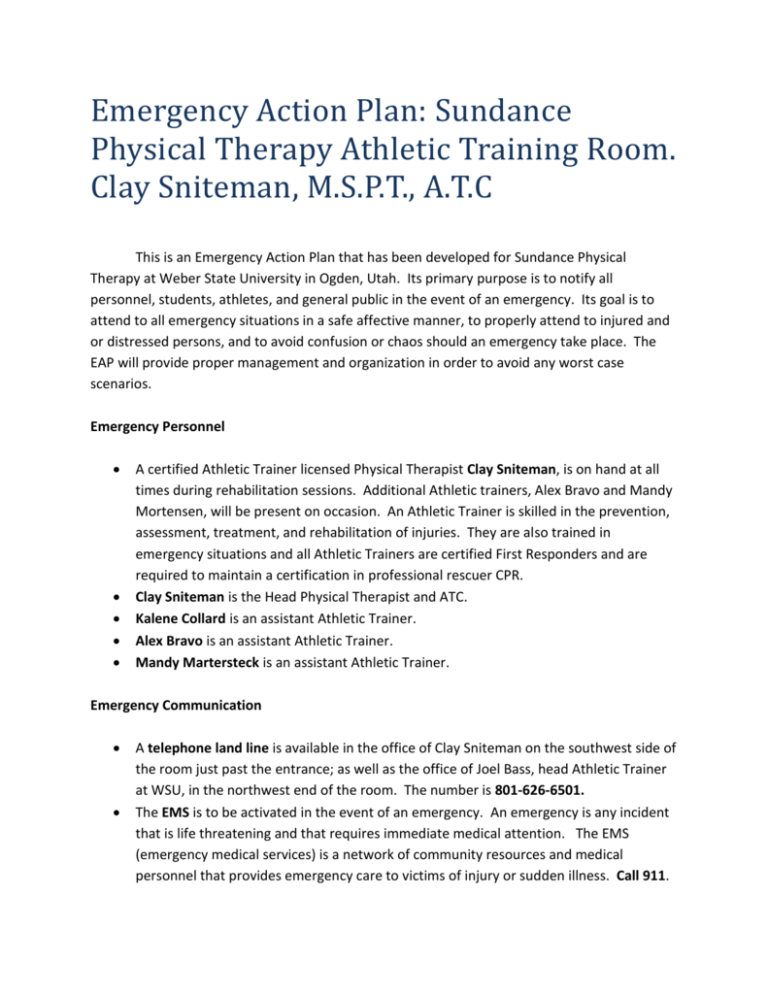Rob Shelton EAP - Weber State University
advertisement

Emergency Action Plan: Sundance Physical Therapy Athletic Training Room. Clay Sniteman, M.S.P.T., A.T.C This is an Emergency Action Plan that has been developed for Sundance Physical Therapy at Weber State University in Ogden, Utah. Its primary purpose is to notify all personnel, students, athletes, and general public in the event of an emergency. Its goal is to attend to all emergency situations in a safe affective manner, to properly attend to injured and or distressed persons, and to avoid confusion or chaos should an emergency take place. The EAP will provide proper management and organization in order to avoid any worst case scenarios. Emergency Personnel A certified Athletic Trainer licensed Physical Therapist Clay Sniteman, is on hand at all times during rehabilitation sessions. Additional Athletic trainers, Alex Bravo and Mandy Mortensen, will be present on occasion. An Athletic Trainer is skilled in the prevention, assessment, treatment, and rehabilitation of injuries. They are also trained in emergency situations and all Athletic Trainers are certified First Responders and are required to maintain a certification in professional rescuer CPR. Clay Sniteman is the Head Physical Therapist and ATC. Kalene Collard is an assistant Athletic Trainer. Alex Bravo is an assistant Athletic Trainer. Mandy Martersteck is an assistant Athletic Trainer. Emergency Communication A telephone land line is available in the office of Clay Sniteman on the southwest side of the room just past the entrance; as well as the office of Joel Bass, head Athletic Trainer at WSU, in the northwest end of the room. The number is 801-626-6501. The EMS is to be activated in the event of an emergency. An emergency is any incident that is life threatening and that requires immediate medical attention. The EMS (emergency medical services) is a network of community resources and medical personnel that provides emergency care to victims of injury or sudden illness. Call 911. Emergency Contact Numbers -Clay Sniteman…801-626-7474 -Kalene Collard…801-626-6501 -Alex Bravo…801-920-1038 -Mandy Martersteck...801-626-9562 -McKay-Dee E.R….801-387-7000 -Ogden Regional Medical Center…801-479-2371 -Ogden City Police…801-629-8221 -Ogden City fire department…801-629-8314 -WSU Police…801-626-6000 -Poison Control…1-880-222-1222 Information to be given when activating EMS Provide your name Exact location of emergency Type of emergency and suspected injury Number of Victims Present condition of the victim(s) Current assistance being given Location of phone being used Specific directions to the site Any other info. needed Be the last to hang up! Chain of Command Clay Sniteman is to head all emergencies if a physician is not present. All others are under his command. If Clay is not on site any assistants or personnel is to head all situations. If no one of authority is available immediately call 911. Emergency Equipment Sundance Physical Therapy/WSU Football Athletic Training Room is located on east side of campus in the tunnel directly under the football bleachers on the west side of the football stadium. Clay Sniteman and all Athletic Trainers have the keys to this facility. In the Athletic Training room there are several supplies for an emergency situation (trauma kit, splint kit, spine board etc.) . There is also an additional Athletic Training Room, which is used by the track team, adjacent to the Football AT room on the south side which also carries emergency medical supplies. In the event of a cardiac emergency there is on hand an Automated External Defibrillator (AED). It is located in the bottom far southwest cupboard of the large island cabinet in the middle of the stadium room. Procedures If there are multiple victims the process of care and sorting will be according to severity. -severity will be graded according to the most life threatening injury Establish the chain of command. All life threatening injuries will be referred to EMTs immediately Non-life threatening injuries will be handled by the Physical Therapist, or Athletic Trainer in that order and depending who is there at the time of incident. Spinal Injuries 1. Check the airway, breathing, and circulation of the victim 2. Call EMS 3. Support the cervical spine by placing both hands on the side of the head. Do not release your hands until instructed to do so by the EMS. 4. Other qualified personnel are to treat for shock while you maintain your position at the head. 5. Do NOT move the victim unless he or she is in immediate danger. When the victim is to be moved back boarding and the proper cervical support by trained individuals is to be done beforehand. 6. Keep the victim calm. Fracture 1. 2. 3. 4. 5. 6. Treat for shock Apply first aid DO NOT ATTEMPT TO REDUCE Splint the affected area or limb Check the distal pulse and sensation Transport the victim to the hospital Joint Dislocations 1. 2. 3. 4. 5. 6. Treat for shock Apply first aid DO NOT REDUCE Splint Check distal pulse Transport the victim to the hospital Cardiac Emergencies 1. 2. 3. 4. 5. Check ABCs and give CPR if necessary Treat for shock Activate EMS Put the victim in a comfortable position Ready AED Environmental Emergencies Earthquakes 1. Remain calm 2. If possible get away from any large objects or elevated objects (especially if electrical). 3. Get into a safe open area or under something sturdy 4. Remain calm until the quake stops 5. Activate chain of command Lightening (Exiting or entering the building during a storm.) 1. Use the 30-30 rule: if there is a count of thirty between the lightening flash and the thunder leave the area. Stay gone for at least 30 minutes. 2. Flash to bang- from the time the lightening is seen to the sound of thunder divide by five to calculate the number of miles away. 3. Avoid large trees poles of any kind, pools of water, telephones, and metal objects including bleachers, umbrellas, and equipment. 4. If there is no shelter seek a safe place such as a car, ravine, ditch or valley for safety. 5. If the hair on your body stands up you are in immediate danger. Get down on the ground and decrease your surface area. Fire 1. 2. 3. 4. Remain calm If the fire is out of control… DO NOT try to put it out! Get out of the area immediately If the fire is attainable there are fire extinguishers located on the east wall and in the offices. As well as in the hall on the north end exit. 5. Call the fire department 6. If you are on fire, stop drop and roll. 7. If needed there is a water outlet on the north end of the room. Facilities The keys to Sundance Physical Therapy/ AT room are held by Clay Sniteman and WSU Athletic Trainers, who will attend all athletic events including practices, games, and certain rehab sessions. Other faculty will also have access to the building (coaches, athletic director, equipment manager etc.). There are two entrances to the building in the tunnel, to which the public can enter, there is a sign posted, Athletic Training. There is also an entrance on the North side of the stadium. Weber State University is located at 3850 University Circle Ogden UT, 84408 o o From the South If you are on Northbound 1-15, take exit 324 near Lagoon. Travel north on US-89 to Harrison Boulevard. Turn right (north) on Harrison Boulevard and go approximately 3 miles to 4100 South. Turn right (east) on 4100 South and follow directional signs. From the North If you are on Southbound 1-15 take the 21st street exit. Continue east to Harrison Boulevard (approximately 4 miles). Turn right (south) on Harrison Boulevard for approximately 3 miles to 4100 South. Turn left (east) on 4100 South and follow directional signs. Emergency Medical Information for individual patients Clay Sniteman has a detailed log of each patient that he is monitoring. This is an accurate record of any patient with a health concern and or injury that is being rehabilitated. The Physical Therapist and Athletic Trainers are aware of any special needs or individual health concerns such as Asthma. He or she has locations of any medications that the individual might have an immediate need of. Guidelines for training of all personnel on site Each academic year the head Physical Therapist/ Athletic Trainer will hold a training with specific instructions on what to do in the event of an emergency. He is to make certain that each person has the adequate training and knowledge pertaining to various duties he or she is to perform relating to this Emergency Action Plan. He will provide a copy of the EAP to all local EMS personnel and physicians (that practice at Sundance PT) or anyone who needs access to the room. Guidelines for updating the EAP Each year the head Physical Therapist/Athletic Trainer will review the current EAP and make any necessary changes. He will then review the document with the location personnel: athletic trainers, athletic director, coaches, legal counsel, EMS, and local staff to clear up any confusion. If there is a change in the staff the Physical Therapist will thoroughly read the EAP and make changes accordingly.





